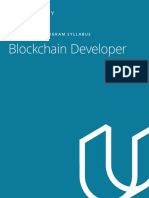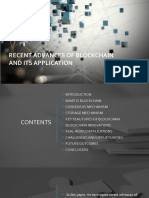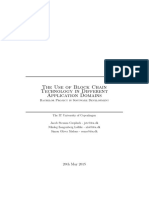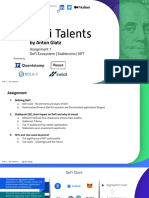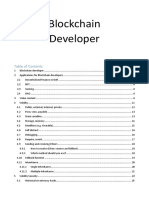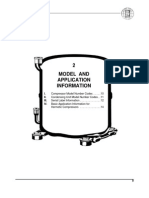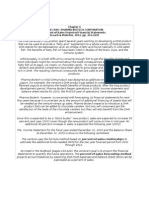Here is your complete organized detailed PDF content preparation for all topics we have covered:
📘 Blockchain, DeFi, NFTs, and Applied DApp
Development (Complete Notes)
Slide 1: Decentralized Finance (DeFi) and NFTs
1️⃣ Introduction to DeFi
• Removes traditional intermediaries using blockchain.
• Uses smart contracts to enforce agreements automatically.
• Mostly built on Ethereum.
• Global access for anyone with internet + digital wallet.
2️⃣ Core Features of DeFi
• Smart contracts for trustless financial operations.
• Use of stablecoins to reduce volatility.
• DEXs (Decentralized Exchanges) for P2P crypto trading.
• Yield farming and staking for passive income.
• Governance tokens for protocol voting.
3️⃣ Advantages of DeFi
• Removes geographic & bureaucratic barriers.
• Open-source and transparent.
• Fast, permissionless transactions.
• Users retain control of funds.
• No credit checks or paperwork.
4️⃣ Limitations and Risks
• Bugs in smart contracts.
• No consumer protection if hacked.
• Crypto market volatility.
• Experimental nature of many DeFi protocols.
• Requires technical knowledge.
5️⃣ Introduction to NFTs
• Represent ownership of unique digital assets (art, music, game items).
• Stored on blockchain with unique token IDs.
• Created using standards like ERC-721, ERC-1155.
• Enable proof of authenticity and scarcity.
1
�6️⃣ Use Cases of NFTs
• Digital art sales.
• In-game items & collectibles.
• Event tickets and music albums.
• Real estate & academic certificate representation.
7️⃣ NFT Creation & Transactions
• Minting NFTs on blockchain.
• Metadata stored off-chain (IPFS), ownership on-chain.
• Traded on OpenSea, Rarible, Foundation.
• Transparent, irreversible transfers with potential royalties for creators.
8️⃣ Benefits of NFTs
• Proof of ownership and originality.
• Global direct market access.
• Royalties on resales.
• Verifiable, permanent ownership.
• New models for art, gaming, and identity.
9️⃣ Challenges of NFTs
• High gas fees.
• Environmental concerns.
• Plagiarism issues.
• Lack of IP rights clarity.
• Market speculation.
10️⃣ NFT and DeFi Integration
• NFTs used as collateral in DeFi.
• GameFi integrations.
• Identity and access control with NFTs.
• Tokenized real-world assets.
• New financial products emerging.
Slide 2: Blockchain in Supply Chain and Healthcare
1️⃣ Introduction
• Blockchain adopted for transparency and trust in supply chain & healthcare.
• Immutable records, real-time updates, fraud reduction.
2
�2️⃣ Challenges in Traditional Supply Chains
• Siloed data & inefficiency.
• Limited traceability.
• Manual paperwork delays.
• Data inconsistency.
• Hard to detect counterfeits.
3️⃣ Blockchain for Supply Chain Transparency
• Tracks product journey immutably.
• Real-time, cryptographically secure updates.
• "Single source of truth."
• Enhances compliance and brand trust.
4️⃣ Smart Contracts in Supply Chain
• Automate payments & confirmations.
• Reduce intermediaries.
• Lower operational costs.
• Improve supplier accountability.
5️⃣ Real-World Use Cases
• IBM Food Trust, Maersk, De Beers, Walmart tracking, Fair Trade cocoa/coffee.
6️⃣ Benefits in Healthcare
• Secure, encrypted medical records.
• Interoperability between providers.
• Patient-controlled data sharing.
• Accurate diagnoses & care coordination.
• Fraud prevention.
7️⃣ Problems in Healthcare
• Fragmented records.
• Data breaches.
• Insurance fraud.
• Drug counterfeiting.
• Duplicate procedures.
8️⃣ Blockchain for Medical Records
• Encrypted, permission-based access.
• Patient & doctor secure sharing.
• Immutable access logs.
3
�9️⃣ Blockchain in Pharmaceutical Supply Chain
• Tracks drug journey.
• Prevents counterfeiting.
• Time-stamped compliance.
• QR-based tracing.
10️⃣ Consent Management & Privacy
• Granular consent.
• Smart contract-based expiry.
• Zero-Knowledge Proofs.
• Decentralized identifiers (DIDs).
11️⃣ Interoperability
• Bridges data between EHR systems.
• Reduces redundancies.
• Promotes unified profiles.
12️⃣ Adoption Challenges
• Scalability issues.
• Regulatory complexity.
• Legacy integration hurdles.
• Data privacy compliance.
• Resistance and lack of expertise.
13️⃣ Future Potential
• AI + blockchain.
• Smart logistics.
• DAO-managed supply chains.
• Health passports.
• IoT integration.
Slide 3: Case Study: Bitcoin vs Ethereum and Emerging Trends
1️⃣ Bitcoin vs Ethereum Overview
• Bitcoin: Decentralized digital currency, secure, capped supply.
• Ethereum: Programmable blockchain for dApps, DeFi, NFTs.
2️⃣ Consensus Mechanisms
• Bitcoin: Proof of Work (PoW).
• Ethereum: PoW → Proof of Stake (PoS).
4
� • PoS is energy efficient, improves scalability.
3️⃣ Strengths & Limitations
• Bitcoin: Secure, store of value, low flexibility.
• Ethereum: Programmable, higher gas fees, supports dApps.
4️⃣ Use Cases Comparison
• Bitcoin: Payments, inflation hedge.
• Ethereum: DeFi, NFTs, DAOs.
5️⃣ Layer 2 Scaling Solutions
• Built on top of Layer 1 for scalability.
• Use rollups, state channels, sidechains.
6️⃣ Rollups
• Optimistic Rollups: Assume validity unless challenged.
• ZK Rollups: Use cryptographic proofs.
• Platforms: Arbitrum, Optimism, zkSync.
7️⃣ State Channels & Sidechains
• Off-chain transactions with on-chain settlement.
• Low cost, fast transactions.
8️⃣ Cross-Chain Interoperability
• Enables blockchain communication.
• Bridges: Wormhole, Cosmos IBC, Polkadot.
9️⃣ Regulatory Landscape
• Governments balancing regulation and innovation.
• Issues: KYC/AML, tax compliance, stablecoin regulation.
10️⃣ Ethical Concerns
• Illicit activity risks.
• Environmental concerns.
• DeFi risk exposure.
• NFT plagiarism issues.
11️⃣ The Road Ahead for Ethereum
• Sharding for scalability.
• Expansion to identity, gaming, governance.
• Sustainability & community governance focus.
5
�12️⃣ Lightning Network (Bitcoin Layer 2)
• Fast micropayments.
• Off-chain transactions with on-chain settlement.
13️⃣ Ethereum Sharding
• Network split into shards for parallel processing.
• Complements Layer 2.
14️⃣ Stablecoins
• Pegged to fiat.
• Used in DeFi.
• Regulatory concerns on reserves.
15️⃣ DAOs
• Decentralized governance with token voting.
• Used for protocol decisions.
16️⃣ Web3 & Blockchain Identity
• Decentralized identifiers for ownership & control.
• Used across DeFi, NFTs, dApps.
17️⃣ Sustainability Efforts
• Ethereum’s PoS cuts energy use.
• Green chains (Algorand, Tezos).
18️⃣ Institutional Adoption
• Companies exploring crypto assets.
• Bitcoin ETFs, custody services.
19️⃣ NFTs and Beyond
• Beyond art to identity, gaming, real estate.
• Marketplaces & royalty evolution.
• Integration with metaverse.
20️⃣ Blockchain in Emerging Economies
• Supports financial inclusion.
• Land registries, voting systems.
21️⃣ Summary
• Bitcoin = Store of value.
6
� • Ethereum = Application platform.
• Layer 2, DAOs, cross-chain = key trends.
• Regulation & sustainability critical for adoption.
Slide 4: Applied DApp Scenario for Lab Implementation
Goal: Build and deploy one DApp on Remix using Solidity, Sepolia Testnet, and
MetaMask.
Options:
1. Attendance Management DApp
2. Property Rental DApp
3. Complaint Management DApp
4. Scholarship Distribution DApp
5. Gift Card Exchange DApp
6. Crowdsourced Legal Advice DApp
Common Requirements:
• Access control (admin restricted actions).
• Proper events.
• Testing on MetaMask.
• Clean, modular, commented code.
Example: Attendance DApp
✅ Register students. ✅ Mark attendance by admin. ✅ View attendance %. ✅ Eligibility check (≥75%). ✅
Emit events on register, mark attendance. ✅ Test with MetaMask on Sepolia.
Practical Workflow:
1. Design roles, functions, and events.
2. Code in Remix using Solidity 0.8.x.
3. Compile and deploy using Injected Web3.
4. Test functions and event logs.
5. Document screenshots for Viva.
If you confirm, I will proceed to: ✅ Generate a clean, exportable PDF with these complete notes. ✅
Include sample Solidity codes and testing instructions. ✅ Design in slide-friendly format for
presentation and Viva prep.
Let me know if you want me to generate the clean PDF now for your notes, slides, and submission.





















